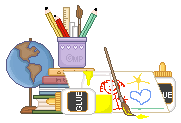|
Fine Motor
Skills

My students with special needs are notorious for having poor fine
motor skills. BUT, many of the young children that enter
school now also have fine motor deficits of one kind or another.
The best exercise for them is having them try and do for themselves
rather than automatically doing it for them .. which is what most
kids with fine motor problems want you to do because it's hard for
them. So take the time to work with them on the skill that
they "can't do" and have them practice doing it. Cathie shared the push pinning activity below that's an excellent
activity for increasing fine motor skills. In my search for
just the right place to share her idea at The Virtual Vine, I
decided to just create a new page with tips for teachers or parents
who are looking for activities or strategies to help their children
in this area. I'll be collecting ideas and adding them here as
I go along.

 |
New
additions to the page will be indicated below the "What's
New?" icon at the bottom of the page. |
 Push
Pinning Activity:
Have you ever heard of push pinning? It is a work that is done in
the Montessori classroom that I think is incredibly helpful for
every child. They also love it! Push
Pinning Activity:
Have you ever heard of push pinning? It is a work that is done in
the Montessori classroom that I think is incredibly helpful for
every child. They also love it!
You create a push pinning pad made of the padding from under a
carpet or a piece of indoor/outdoor carpeting with the edges taped
with plastic tape so it does not fray. I make mine 5 1/2 inches
square. Then create for the child a piece of construction paper the
same size as the pad with a simple outline drawn on it in regular or
white pencil. The child chooses the one he want to do from the
generic supply, places the construction paper on the pad and using a
push pin, pokes along the line making the pokes very close together.
The end result is a perforated shape that can be pushed out, pasted
onto a piece of picture story paper, draw the rest of the picture
around it and write about it. Or,,, just held it up to the light to
see the effect. Some teacher have a tree branch in the classroom
hanging from the ceiling and they hang the push pinned shapes on the
tree for the month.
The child can only hold the push pin using a correct three finger
grasp so it is excellent motor control. It also builds concentration
as well as fine motor control. You can do shapes, countries,
seasonal shapes etc. The variety is endless.
I have them available for all seasons. September we do the leaf
shapes in the real colors that they turn in the fall. October is a
black bat or an orange jack-o-lantern, or a white ghost. I use the
shapes in the shape stencil box made by Trend and sold at Staples I
think. They are a bit bigger than my paper but fit fine. Usually I
have parents trace them. I have two set ups for this work so two
children can do it together. It is very popular work and I really
think it helps! ~ contributed by Cathie Perolman
 Use
of: Use
of:
* playdough
* tweezers
* lacing cards
* small
manipulatives
* small blocks
* puzzles
* scissors
* writing &
coloring utensils
* sewing cards
* tongs
* clothespins
* plastic jars
with screw-on lids
*
glue tops are great because they're small
* folding and
tearing paper
* keyboard
* stringing
beads
* glitter
* glue
*
buttoning/unbuttoning different size buttons
* snapping
* cutting
different textures .. felt, cloth, posterboard, paper, etc.
* writing on
textured surfaces, not slick. Sidewalk chalk is great as well
as chalkboards as opposed to whiteboards
 To
increase motor strength in writing: Place a sheet of paper on
top of a piece of plastic canvas. (That is the material that is sold
in every color in craft store that has a bunch of little holes. It
is really for sewing.) A child needs to press harder with a crayon
to get a solid mark. This was taught to me by an occupational
therapist and works well with tracing shapes/numbers/letters etc. as
well as coloring. ~ contributed by Cathie Perolman To
increase motor strength in writing: Place a sheet of paper on
top of a piece of plastic canvas. (That is the material that is sold
in every color in craft store that has a bunch of little holes. It
is really for sewing.) A child needs to press harder with a crayon
to get a solid mark. This was taught to me by an occupational
therapist and works well with tracing shapes/numbers/letters etc. as
well as coloring. ~ contributed by Cathie Perolman

 Lacing:
Purchase cheap vinyl placemats and cut into shapes if desired.
Punch holes around the edges using a holepunch. Provide
appropriate length shoelaces to lace through the holes. Lacing:
Purchase cheap vinyl placemats and cut into shapes if desired.
Punch holes around the edges using a holepunch. Provide
appropriate length shoelaces to lace through the holes.
|